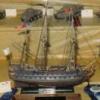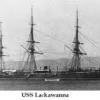MORE HANDBOOKS ARE ON THEIR WAY! We will let you know when they get here.
×
-
Posts
1,301 -
Joined
-
Last visited
Reputation Activity
-
 MrBlueJacket got a reaction from ScottRC in Red Jacket by MrBlueJacket - FINISHED - BlueJacket Shipcrafters - Scale 1/8" = 1' (1:96)
MrBlueJacket got a reaction from ScottRC in Red Jacket by MrBlueJacket - FINISHED - BlueJacket Shipcrafters - Scale 1/8" = 1' (1:96)
Trim the ends, apply a spot of fabric cement to the back of the upper loop, and install. Very convincing look.
-
 MrBlueJacket got a reaction from shipman in scribed deck caulk lines
MrBlueJacket got a reaction from shipman in scribed deck caulk lines
I agree with Roger. It could be any two non-compatible finishes. For example, enamel first, then acrylics. Or, acrylics, then enamel. The ides is that when you wipe off the caulk color, that solvent won't eat at the underlying finish.
Nic
-
 MrBlueJacket got a reaction from EricWilliamMarshall in Red Jacket by MrBlueJacket - FINISHED - BlueJacket Shipcrafters - Scale 1/8" = 1' (1:96)
MrBlueJacket got a reaction from EricWilliamMarshall in Red Jacket by MrBlueJacket - FINISHED - BlueJacket Shipcrafters - Scale 1/8" = 1' (1:96)
Trim the ends, apply a spot of fabric cement to the back of the upper loop, and install. Very convincing look.
-
 MrBlueJacket got a reaction from ScottRC in Red Jacket by MrBlueJacket - FINISHED - BlueJacket Shipcrafters - Scale 1/8" = 1' (1:96)
MrBlueJacket got a reaction from ScottRC in Red Jacket by MrBlueJacket - FINISHED - BlueJacket Shipcrafters - Scale 1/8" = 1' (1:96)
Then slide the loose thread end through the groove and knot it in the middle of the coil. Use a tiny drop of CA to secure the knot. Then slip the coil off the jig, spread out the upper end a little.
-
 MrBlueJacket got a reaction from ScottRC in Red Jacket by MrBlueJacket - FINISHED - BlueJacket Shipcrafters - Scale 1/8" = 1' (1:96)
MrBlueJacket got a reaction from ScottRC in Red Jacket by MrBlueJacket - FINISHED - BlueJacket Shipcrafters - Scale 1/8" = 1' (1:96)
Clasmp the end of the thread with the clothespin on the right side of the picture. Then put three wraps of thread aroiund the pins, and clamps the left pin with the clohespin with the hole in it.
-
 MrBlueJacket got a reaction from EricWilliamMarshall in Red Jacket by MrBlueJacket - FINISHED - BlueJacket Shipcrafters - Scale 1/8" = 1' (1:96)
MrBlueJacket got a reaction from EricWilliamMarshall in Red Jacket by MrBlueJacket - FINISHED - BlueJacket Shipcrafters - Scale 1/8" = 1' (1:96)
Last night I made a few rope coils. Here's how to do it. First, the equipment - a strip of wood with a groove and two pins, two reversed clothspins, one of which has a hole in it, and of course the thread.
-
 MrBlueJacket got a reaction from GrandpaPhil in Red Jacket by MrBlueJacket - FINISHED - BlueJacket Shipcrafters - Scale 1/8" = 1' (1:96)
MrBlueJacket got a reaction from GrandpaPhil in Red Jacket by MrBlueJacket - FINISHED - BlueJacket Shipcrafters - Scale 1/8" = 1' (1:96)
Trim the ends, apply a spot of fabric cement to the back of the upper loop, and install. Very convincing look.
-
 MrBlueJacket got a reaction from EricWilliamMarshall in Red Jacket by MrBlueJacket - FINISHED - BlueJacket Shipcrafters - Scale 1/8" = 1' (1:96)
MrBlueJacket got a reaction from EricWilliamMarshall in Red Jacket by MrBlueJacket - FINISHED - BlueJacket Shipcrafters - Scale 1/8" = 1' (1:96)
Then slide the loose thread end through the groove and knot it in the middle of the coil. Use a tiny drop of CA to secure the knot. Then slip the coil off the jig, spread out the upper end a little.
-
 MrBlueJacket got a reaction from EricWilliamMarshall in Red Jacket by MrBlueJacket - FINISHED - BlueJacket Shipcrafters - Scale 1/8" = 1' (1:96)
MrBlueJacket got a reaction from EricWilliamMarshall in Red Jacket by MrBlueJacket - FINISHED - BlueJacket Shipcrafters - Scale 1/8" = 1' (1:96)
Clasmp the end of the thread with the clothespin on the right side of the picture. Then put three wraps of thread aroiund the pins, and clamps the left pin with the clohespin with the hole in it.
-
 MrBlueJacket got a reaction from GrandpaPhil in Red Jacket by MrBlueJacket - FINISHED - BlueJacket Shipcrafters - Scale 1/8" = 1' (1:96)
MrBlueJacket got a reaction from GrandpaPhil in Red Jacket by MrBlueJacket - FINISHED - BlueJacket Shipcrafters - Scale 1/8" = 1' (1:96)
Last night I made a few rope coils. Here's how to do it. First, the equipment - a strip of wood with a groove and two pins, two reversed clothspins, one of which has a hole in it, and of course the thread.
-
 MrBlueJacket got a reaction from closehaul in scribed deck caulk lines
MrBlueJacket got a reaction from closehaul in scribed deck caulk lines
I agree with Roger. It could be any two non-compatible finishes. For example, enamel first, then acrylics. Or, acrylics, then enamel. The ides is that when you wipe off the caulk color, that solvent won't eat at the underlying finish.
Nic
-
 MrBlueJacket got a reaction from mtaylor in scribed deck caulk lines
MrBlueJacket got a reaction from mtaylor in scribed deck caulk lines
I agree with Roger. It could be any two non-compatible finishes. For example, enamel first, then acrylics. Or, acrylics, then enamel. The ides is that when you wipe off the caulk color, that solvent won't eat at the underlying finish.
Nic
-
 MrBlueJacket got a reaction from Roger Pellett in scribed deck caulk lines
MrBlueJacket got a reaction from Roger Pellett in scribed deck caulk lines
I agree with Roger. It could be any two non-compatible finishes. For example, enamel first, then acrylics. Or, acrylics, then enamel. The ides is that when you wipe off the caulk color, that solvent won't eat at the underlying finish.
Nic
-
 MrBlueJacket got a reaction from Canute in scribed deck caulk lines
MrBlueJacket got a reaction from Canute in scribed deck caulk lines
I agree with Roger. It could be any two non-compatible finishes. For example, enamel first, then acrylics. Or, acrylics, then enamel. The ides is that when you wipe off the caulk color, that solvent won't eat at the underlying finish.
Nic
-
 MrBlueJacket got a reaction from Elijah in Red Jacket by MrBlueJacket - FINISHED - BlueJacket Shipcrafters - Scale 1/8" = 1' (1:96)
MrBlueJacket got a reaction from Elijah in Red Jacket by MrBlueJacket - FINISHED - BlueJacket Shipcrafters - Scale 1/8" = 1' (1:96)
Thank you.
-
 MrBlueJacket got a reaction from ScottRC in Red Jacket by MrBlueJacket - FINISHED - BlueJacket Shipcrafters - Scale 1/8" = 1' (1:96)
MrBlueJacket got a reaction from ScottRC in Red Jacket by MrBlueJacket - FINISHED - BlueJacket Shipcrafters - Scale 1/8" = 1' (1:96)
All those blocks now added to the yards, and they are now hung on the masts. All askew until I add the lifts this weekend. And the halyards, and the sheet sand clews.
-
 MrBlueJacket got a reaction from EricWilliamMarshall in Red Jacket by MrBlueJacket - FINISHED - BlueJacket Shipcrafters - Scale 1/8" = 1' (1:96)
MrBlueJacket got a reaction from EricWilliamMarshall in Red Jacket by MrBlueJacket - FINISHED - BlueJacket Shipcrafters - Scale 1/8" = 1' (1:96)
All those blocks now added to the yards, and they are now hung on the masts. All askew until I add the lifts this weekend. And the halyards, and the sheet sand clews.
-
 MrBlueJacket got a reaction from BobMcM in Red Jacket by MrBlueJacket - FINISHED - BlueJacket Shipcrafters - Scale 1/8" = 1' (1:96)
MrBlueJacket got a reaction from BobMcM in Red Jacket by MrBlueJacket - FINISHED - BlueJacket Shipcrafters - Scale 1/8" = 1' (1:96)
All those blocks now added to the yards, and they are now hung on the masts. All askew until I add the lifts this weekend. And the halyards, and the sheet sand clews.
-
 MrBlueJacket got a reaction from GrandpaPhil in Red Jacket by MrBlueJacket - FINISHED - BlueJacket Shipcrafters - Scale 1/8" = 1' (1:96)
MrBlueJacket got a reaction from GrandpaPhil in Red Jacket by MrBlueJacket - FINISHED - BlueJacket Shipcrafters - Scale 1/8" = 1' (1:96)
All those blocks now added to the yards, and they are now hung on the masts. All askew until I add the lifts this weekend. And the halyards, and the sheet sand clews.
-
 MrBlueJacket got a reaction from Roger Pellett in Red Jacket by MrBlueJacket - FINISHED - BlueJacket Shipcrafters - Scale 1/8" = 1' (1:96)
MrBlueJacket got a reaction from Roger Pellett in Red Jacket by MrBlueJacket - FINISHED - BlueJacket Shipcrafters - Scale 1/8" = 1' (1:96)
All those blocks now added to the yards, and they are now hung on the masts. All askew until I add the lifts this weekend. And the halyards, and the sheet sand clews.
-
 MrBlueJacket got a reaction from ScottRC in Red Jacket by MrBlueJacket - FINISHED - BlueJacket Shipcrafters - Scale 1/8" = 1' (1:96)
MrBlueJacket got a reaction from ScottRC in Red Jacket by MrBlueJacket - FINISHED - BlueJacket Shipcrafters - Scale 1/8" = 1' (1:96)
All the topsail sheets and clew lines are done. Here's a shot of the mizzen
Next will be making the t'gallant yards.
-
 MrBlueJacket got a reaction from EricWilliamMarshall in Red Jacket by MrBlueJacket - FINISHED - BlueJacket Shipcrafters - Scale 1/8" = 1' (1:96)
MrBlueJacket got a reaction from EricWilliamMarshall in Red Jacket by MrBlueJacket - FINISHED - BlueJacket Shipcrafters - Scale 1/8" = 1' (1:96)
Here's the 3 t'gallant yards in process.
-
 MrBlueJacket got a reaction from EricWilliamMarshall in Red Jacket by MrBlueJacket - FINISHED - BlueJacket Shipcrafters - Scale 1/8" = 1' (1:96)
MrBlueJacket got a reaction from EricWilliamMarshall in Red Jacket by MrBlueJacket - FINISHED - BlueJacket Shipcrafters - Scale 1/8" = 1' (1:96)
And here they are ready for painting. I use .010" wire for the footropes, they always get bent around when I do the rigging, so I won't straighten them out until the end. The fore and main have 15 holes drilled, and 7 eyebolts each.
-
 MrBlueJacket got a reaction from ScottRC in Red Jacket by MrBlueJacket - FINISHED - BlueJacket Shipcrafters - Scale 1/8" = 1' (1:96)
MrBlueJacket got a reaction from ScottRC in Red Jacket by MrBlueJacket - FINISHED - BlueJacket Shipcrafters - Scale 1/8" = 1' (1:96)
And here they are ready for painting. I use .010" wire for the footropes, they always get bent around when I do the rigging, so I won't straighten them out until the end. The fore and main have 15 holes drilled, and 7 eyebolts each.
-
 MrBlueJacket got a reaction from EricWilliamMarshall in Red Jacket by MrBlueJacket - FINISHED - BlueJacket Shipcrafters - Scale 1/8" = 1' (1:96)
MrBlueJacket got a reaction from EricWilliamMarshall in Red Jacket by MrBlueJacket - FINISHED - BlueJacket Shipcrafters - Scale 1/8" = 1' (1:96)
Got the foremast topsail sheet and clew done this afternoon. Hard to see the "cloverleaf block" under the foreyard, but the chain is belayed to the pinrail, then through the cloverleaf block, the out to the sheave at the end of the yard (remember when I put those in?) and then to a single block, which receives a line from the topmast near the center, then down to the pinrail. The sheet tackle is .015, while the clew is .010. This is because the sheet carries a lot of force when he sail is deployed, but the clew only pulls up the sail itself.





.thumb.jpeg.fc5d633a7b34428fcf19419a73d56d55.jpeg)



